[The principle ideas of the following findings were already announced on page 110 of the article: Marc Lewon: Wie klang Minnesang? Eine Skizze zum Klangbild an den Höfen der staufischen Epoche, in: Dichtung und Musik der Stauferzeit. Wissenschaftliches Symposium der Stadt Worms vom 12. bis 14. November 2010, ed. Volker Gallé, (= Schriftenreihe der Nibelungenlied-Gesellschaft Worms, Bd. 7), Worms 2011, S. 69-123. With this blog entry I would like to follow up some leads which I could not lay out in full in said article.]
In 2002 Lothar Voetz, one of my professors for medieval German literature at Heidelberg University, published an interesting article on the well-known Neidhart miniature in the famous Codex Manesse: “Beobachtungen zur Neidhart-Miniatur im Codex Manesse”, in: Ars et Scientia. Festschrift für Hans Szklenar zum 70. Geburtstag, ed. by Roswitha Wisniewski and Carola L. Gottzmann, Berlin 2002, p. 135-156.
In his article Voetz convincingly shows how the painter of the Neidhart miniature composed the picture by using a well-established iconic archetype as a model for the image build-up. The miniature shows the minnesinger Neidhart in the centre of the picture with one hand raised in a vowing and the other in a rejecting gesture. He is surrounded by four individuals frozen in expressive arm and hand movements, wearing outfit, which by the standards of the Codex Manesse miniatures can only be described as extravagant and unusual. Their features also are amongst the most extreme of the otherwise very bland and stylised facial expressions found in the codex, almost bordering on the grotesque.
Lothar Voetz found that the artist of this picture used a model to compose the miniature, which he apparently found within the canon of pictures in the Speculum humanae salvationis. Particularly the depiction in the Manuscript Kremsmünster, Stiftsbibliothek, Codex 243, fol. 30va, caught his attention. In this picture captioned “Synagoga derisit Christum regem suum et dominum”, which depicts the mockery of Jesus, four “jews” turn onto the cross and taunt Jesus:
With the identification of this model Voetz not only demonstrated how professional workshops in Southern Germany c1300 went about the creation of new pictures, but also proved that the figures surrounding Neidhart in his “portrait” are by no means benevolent “friends”, but actually (as was long assumed) the “dörper”-antagonists of the lyrical self. These “villains” from Neidhart’s own songs habitually turn against the singer and taunt him. The artist of the Neidhart miniature obviously recognised this connection and thus did not only find a model to create a new picture, but also gave another layer of meaning to the depicted scene.
Voetz’ discovery was long dormant in my mind when I was reminded of it in 2011 at a conference in South Tyrol. My doctoral advisor Reinhard Strohm gave a lecture at the symposium when he showed a late medieval depiction of Lady Music, surrounded by musical instruments. I was reminded of the Notre Dame depiction of Musica instrumentalis as the third and lowest of the threefold depiction of Musica mundana, Musica humana, and Musica instrumentalis in the Florence Manuscript (Firenze, Biblioteca mediceo-laurenziana, Pluteo 29.1, fol. 1v) and suddenly saw the parallels to the famous Frauenlob miniature in Codex Manesse (Heidelberg, Universitätsbibliothek, cpg 848, fol. 399r). I laid the two next to each other and could not but be amazed at their similar make-up:
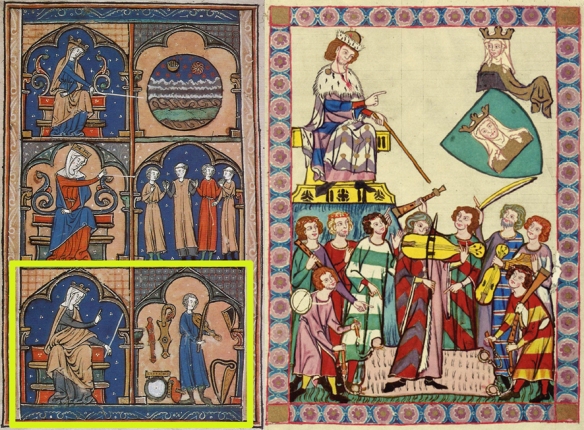
Threefold “Musica” with “musica instrumentalis” marked: Firenze, Biblioteca mediceo-laurenziana, Pluteo 29.1, fol. 1v and “Meister Heinrich Vrouwenlob”: Heidelberg, Universitätsbibliothek, cpg 848, fol. 399r.
The parallels are most striking: Both pictures are clearly divided into two image fields. In the case of Musica the fields are situated next to each other. This is of course due to the layout of the threefold musica-picture in the Florence Manuscript, where the vertical structures are taken up by the different characters and hierarchical classes of musica mundana, musica humana, and musica instrumentalis, of which only the latter—the actual “sounding music”—is of interest here. In the case of Frauenlob, where a whole page was available to the painter, the setup is vertical with the two image fields situated above one another:
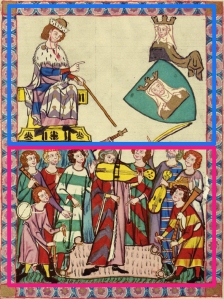 In both cases the hierarchically higher field is taken up by a figure sitting on a throne in a slightly inclined posture:
In both cases the hierarchically higher field is taken up by a figure sitting on a throne in a slightly inclined posture:
In both cases the figure is raising a finger and holding a staff in its hand:
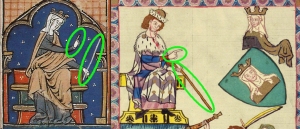 Furthermore the figure in the musica depiction, Lady Music herself, is wearing a veil and crown, almost identical to the female in the coat of arms and on the helmet decoration in the Frauenlob miniature (both of them fantasy-heraldry):
Furthermore the figure in the musica depiction, Lady Music herself, is wearing a veil and crown, almost identical to the female in the coat of arms and on the helmet decoration in the Frauenlob miniature (both of them fantasy-heraldry):
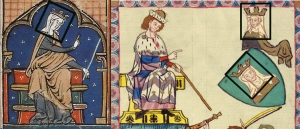 The second image field contains one musician in the centre playing a musical instrument—in both cases a vielle, the most important of secular instruments, and the most suitable to accompany cantus coronatus, i.e. minnesang (see Grocheio’s appraisal of the instrument). This player, whose posture (and even greyish hair—interestingly, the only other musician holding a vielle, features the same grey hair and beard) is almost identical in both miniatures, is surrounded by 6 other instruments. In the case of the musica depiction, these instruments seem to hang on the walls or lie on the floor, while in the case of the Frauenlob miniature they are being held by a surrounding group of other instrumental soloists. In both cases the number of instruments (and in one case the combination of two instruments, which only together form an entity: pipe and tabor) amounts to an allegorical number of 7:
The second image field contains one musician in the centre playing a musical instrument—in both cases a vielle, the most important of secular instruments, and the most suitable to accompany cantus coronatus, i.e. minnesang (see Grocheio’s appraisal of the instrument). This player, whose posture (and even greyish hair—interestingly, the only other musician holding a vielle, features the same grey hair and beard) is almost identical in both miniatures, is surrounded by 6 other instruments. In the case of the musica depiction, these instruments seem to hang on the walls or lie on the floor, while in the case of the Frauenlob miniature they are being held by a surrounding group of other instrumental soloists. In both cases the number of instruments (and in one case the combination of two instruments, which only together form an entity: pipe and tabor) amounts to an allegorical number of 7:
- vielle
- harp-psaltery
- harp
- bagpipe
- pipe & tabor
- free-neck citole
- thumb-hole citole
Frauenlob:
- vielle
- shawm
- vielle
- psaltery
- bagpipe
- tabor (pipe probably hidden)
- transverse flute
I would like to suggest the following interpretation:
Because Frauenlob was held in such high esteem by his contemporaries (and by generations to come) as one of the greatest masters and teachers of music, the painter of his miniature apparently found it adequate to compare or associate him with the highest authority in the field: the personified Lady Music herself. It has been suspected before that Frauenlob might be identified with the vielle-player in the middle of the lower image field, who is also more kingly dressed than the surrounding onlookers. But by analogy with Lady Music’s position in the supposed model it seems that the person sitting on the throne must be Meister (= Master, i.e. Magister) Heinrich Frauenlob as an allegorical emperor and teacher of his “school”. The coat of arms and helmet crest mirrors the image of Lady Music from the model but at the same time is reinterpreted here as the “woman” in his sobriquet “Frauenlob” (“he who praises women”) and simultaneously as the Virgin Mary, who is actually the addressee of his most extensive and best-known song of praise, his “Marienleich” (“Lai to the Virgin Mary”). The painted scene in the Frauenlob miniature may thus be read as the standardised depiction of a teaching situation, however realistic (in case of an assumed “school” led by Frauenlob) or symbolic (in case of his invisible influence on his followers and successors), superimposed on the personified idea of a governing principle (i.e. Lady Music)—the concept of a higher, invisible guiding force behind the sounding phenomenon of music.
There are other depictions of “musica” which reiterate some of the observed details of this assumed archetype: The image of the crowned Lady Music sitting on a throne-like structure, sometimes with a raised hand or finger and often surrounded by instruments (which seems to be a fairly obvious setting) is well-established. However, no other depiction of “musica” or “musica instrumentalis” that I am aware of, comes nearly as close to the Frauenlob miniature as the one in the Florence Manuscript. Thus it might be a bit premature to proclaim a “new” archetypical layout for musica depictions with this being the only unequivocal piece of evidence. It is on the other hand maybe not a coincidence that both the Florence “musica instrumentalis” and the Frauenlob miniature fit so well with their respective dating of c1250 and 1305.
Even though it may seem superfluous to mention, I would like to point to a misconception, which occasionally still can be found in mainstream publications: In his miniature Frauenlob is not “conducting” an “orchestra”, as had been suggested in earlier descriptions and interpretations. For one the concept of an orchestra and a conductor (and especially the conductor’s baton) was yet many centuries away, furthermore the depicted staff was a typical attribute for a teacher, as was the gesture of the raised finger, which still is a symbol of instruction today (even if considered bad form). Finally the assorted musicians are all merely holding their instruments, while only one is actually playing—just as in the Florence depiction of “musica instrumentalis”.
Marc Lewon
[2015-03-14] Update 1: The contents of this blog entry including additional observations concerning the Regenbogen-miniature in Codex Manesse and Pythagoras depictions (see the comment by Michael Shields to this entry) can be found as a published article: Marc Lewon: “Meister Heinrich Frauenlob und Frau Musica. Eine neue Deutung der Frauenlob-Miniatur im ‘Codex Manesse'”, in: Klein, Dorothea und Hübner, Gert (eds.): Sangspruchdichtung um 1300. Akten der Tagung in Basel vom 7. bis 9. November 2013, Hildesheim (Weidmannsche Verlagsbuchhandlung) 2015 (Spolia Berolinensia, vol. 33), pp. 293–306.
[2015-06-21] Update 2: I was just made aware via an excellent article which adds new observations to the interpretation of the Fraubenlob-miniature by Henry Hope („Miniatures, Minnesänger, music: the Codex Manesse“, in: Deeming, Helen and Elizabeth Eva Leach (eds.): Manuscripts and Medieval Song, Cambridge (Cambridge University Press) 2015, pp. 163–192) that some of the central ideas put forth in this blog entry were already discovered and published by Dagmar Axthelm: Hoffmann-Axthelm, Dagmar: „Doctor Frauenlobs Hohes Lied. Ein Autorenbild aus der Manessischen Liederhandschrift als Topos-Mosaik“, in: Basler Jahrbuch für Historische Musikpraxis, vol. 11, Winterthur (Amadeus Verlag) 1987, pp. 153–172.
PS (Prospect): The concept of elevating exceptional musicians to the status of representatives of “Musica” herself seems to have caught on towards the later Middle Ages. Francesco Landini and Giovanni Mazzuoli, both playing the portative organ in the Codex Squarcialupi and surrounded by instruments in the margin decorations, are highly reminiscent of contemporary “Lady Music”-depictions on the one hand and of the Frauenlob-miniature on the other:
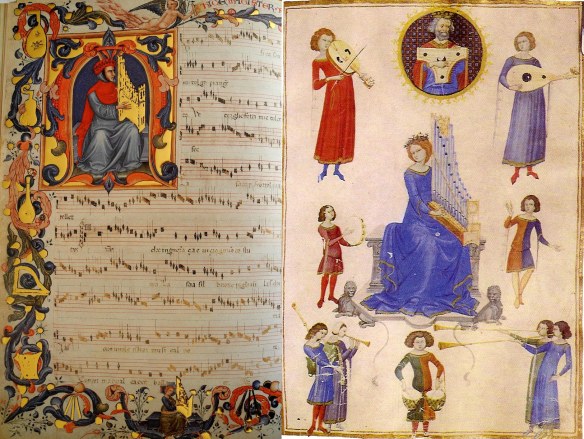
Miniature of Francesco Landini in Codex Squarcialupi (I-Fl Med. Pal. 87, fol. 121v; c1410–15) & representation of “Lady Music” with alta and bassa instruments (I-Nn Ms. VA 14, fol. 17r).
The tombstone of Conrad Paumann in Munich seems to draw on a similar concept, especially since the epitaph above it declares him as “der musica maister”, i.e. the “master of music” or “Musica’s magister”:
For more background and a commented catalogue on medieval allegorical depictions of Lady Music in its relationship to the depiction of musicians from the same time, see Tilman Seebass: “Lady Music and her protégés: from musical allegory to musicians’ portraits”, in: Musica Disciplina, vol. XLII (1988), pp. 23-61.
 This work is licensed under a Creative Commons Attribution-NonCommercial-ShareAlike 4.0 International License.
This work is licensed under a Creative Commons Attribution-NonCommercial-ShareAlike 4.0 International License.
A new article has recently been published which addresses and explains the late medieval concept of “musica” very sensibly and with particular attention to the creators of German monophonic song; see: Strohm, Reinhard: “Lied und Musik”, in: Oswald von Wolkenstein im Kontext der Liedkunst seiner Zeit (= Jahrbuch der Oswald von Wolkenstein-Gesellschaft, Bd. 19), Wiesbaden (Reichert Verlag) 2012/2013.
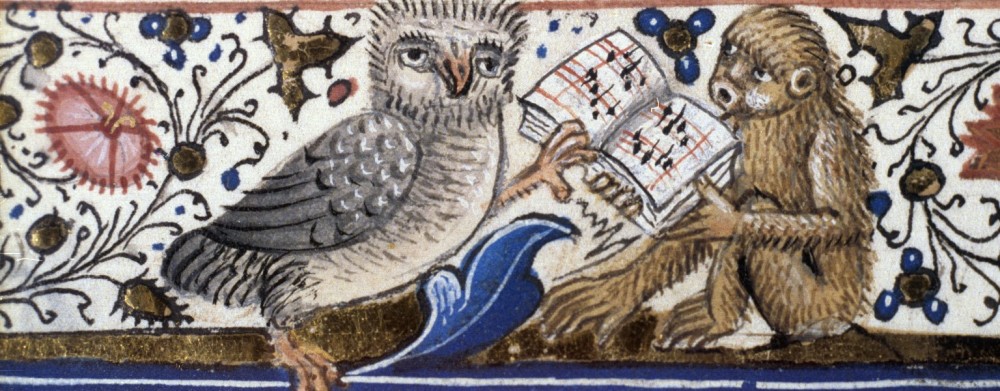



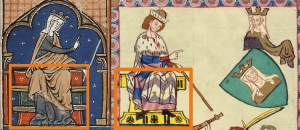
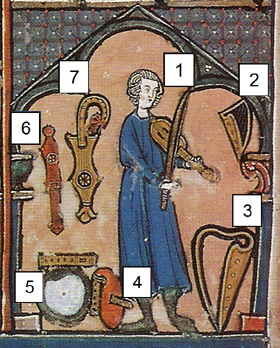
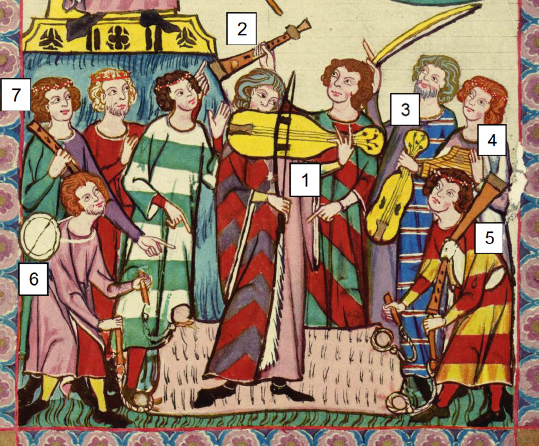
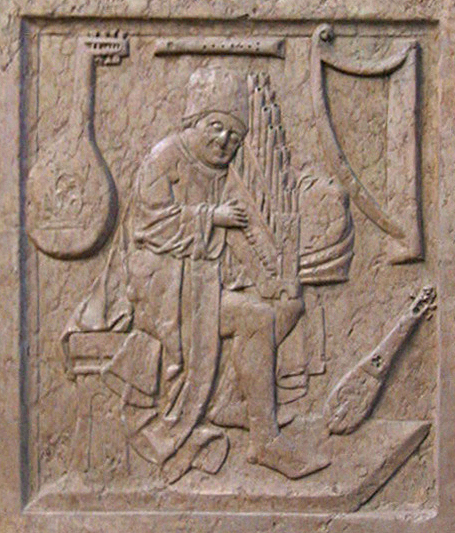
Well spotted, Marc- the parallels are fascinating and convincing! I can add a few small observations.
1) There is one additional reason for thinking the man in the throne is Frauenlob: the garment he is wearing has the same pattern as that of the man talking with Regenbogen in the miniature for that singer (fol. 381r: violet and white zigzag pattern with gold dots). This connection was noted in the commentary by Ingo F. Walther/Gisela Siebert, Codex Manesse. Die Miniaturen der Großen Heidelberger Liederhandschrift, Insel 1988 p.264.
2) One could also wonder whether the Regenbogen miniature also alludes to an iconographical model, namely Pythagoras in the smith’s forge. However, unlike Pythagoras Regenbogen (beardless and dressed in red) just has one hammer, and the two singers do not appear to be discovering the principles of harmony from its weight. Peter Gülke, “Mönche, Bürger, Minnesänger” reproduces two miniatures of Pythagoras in the forge (Reims, bibliothèque municipale 672 fol 1v and Munich, bsb clm 2599 fol.96v) alongside a photo of your MS Firenze, Biblioteca mediceo-laurenziana, Pluteo 29.1, fol. 1v. Maybe somebody knows other depictions of Pythagoras that are closer to the Regenbogen miniature.
3) In the Frauenlob miniature, it is just possible that the young bearded singer, dressed in red and sporting a red wreath in his hair, might be Regenbogen, here portrayed in the role of a practical musician. (In that case one would want to ask who the other singer is, in the blue and white horizontal stripes.)
4) The contrast between music theory and practice is heightened by the fact that Frauenlob is young and the central musician is old (grey hair). This could be a reference to a topos: using theory one advances quickly, using practice without intellect one can spend one’s days trying to attain the same goal. Or is it significant that the two grey-haired musicians are both vielle players? The other practical musicians are all young.
5) The schematic opposition between music theory and practice helps to explain another peculiar feature of the Frauenlob miniature, the portable rug (cowhide trampoline?) upon which the vielle player is standing. If there is a schematic correspondence between elements in the upper and lower sections of the miniature, then the jongleuresque “trampoline” corresponds to the carved throne upon which the theoretician Frauenlob is sitting. It would be interesting to collect other pictures of these blankets.
Michael Shields
Dear Michael,
Thank you very much for these additional and valuable observations. I think we are on to something, here. Let’s keep our eyes peeled. It is fascinating to think about these “intertextual” links between the miniatures – and particularly with regard to topical depictions of “music” (i.e. “musica”, “Pythagoras’ forge”, etc.).
Best,
Marc
Thank you for sharing your findings in this blog. For me you have shed new light on these images which I would otherwise have remained ignorant of.
Pingback: The Codex Manesse – Music Beyond Musical Notation | Musicology in the Making